(完整版)小升初英语语法点总结及练习,推荐文档
- 格式:pdf
- 大小:375.46 KB
- 文档页数:48

小升初英语语法总结及练习小升初语法名词 (2)名词练习题 (3)能力测试卷(名词) (4)小升初语法代词 (5)代词练习题 (7)能力测试卷(代词) (8)小升初语法数词和冠词 (9)冠词和数词专项练习 (11)能力测试卷(冠词和数词) (12)小升初语法动词 (13)动词练习题 (14)能力测试题(动词) (15)小升初语法一般将来时 (16)一般将来时练习题 (17)能力测试题(一般将来时) (18)小升初语法一般过去时 (19)一般过去时练习题 (20)能力测试(一般过去时) (21)小升初语法一般现在时态 (22)一、一般现在时的定义 (22)二、一般现在时的结构 (22)一般现在时态专项练习 (24)能力测试卷(一般现在时) (25)小升初语法现在进行时态 (26)能力测试卷(现在进行时态) (30)小升初语法句型之肯定句和否定句 (31)疑问句专项练习 (34)小升初语法句型之祈使句 (35)小升初语法句型there be与have\has 句型 (37)句型专项练习题 (38)小学阶段不规则动词全表 (44)动词四种形式变化规则汇总表 (45)小升初语法名词一、名词复数规则二、1.一般情况下,直接加-s,如:book-books, bag-bags, cat-cats, bed-beds三、2.以s. x. sh. ch结尾,加-es,如:bus-buses, box-boxes, brush-brushes, watch-watches四、3.以“辅音字母+y”结尾,变y为i, 再加-es,如:family-families, strawberry-strawberries以“元音字母+y”结尾,直接加s,如:boy - boys ,day - days4. 以“f或fe”结尾,变f或fe为v, 再加-es,如:knife-knives5.以o结尾的单词:a, 有生命的+es b, 无生命+s如:potato--potatoes ;hero--heroes;mango--mangoes photo--photos ; radio -- radios ; video -- videos6. 不规则名词复数:man-menwoman-womenpoliceman-police menmouse-micechild-childrenfoot-feettooth-teethfish-fishpeople-peopleChinese-ChineseJapanese-Japanesedeer - deersheep-sheeppolicewoman-policewomen二、名词所有格的构成法1. 主要是在词尾加’ s 构成。
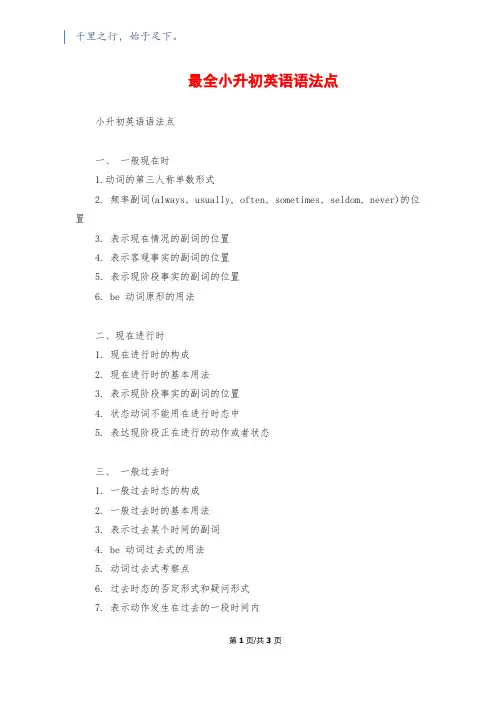
千里之行,始于足下。
最全小升初英语语法点小升初英语语法点一、一般现在时1.动词的第三人称单数形式2. 频率副词(always, usually, often, sometimes, seldom, never)的位置3. 表示现在情况的副词的位置4. 表示客观事实的副词的位置5. 表示现阶段事实的副词的位置6. be 动词原形的用法二、现在进行时1. 现在进行时的构成2. 现在进行时的基本用法3. 表示现阶段事实的副词的位置4. 状态动词不能用在进行时态中5. 表达现阶段正在进行的动作或者状态三、一般过去时1. 一般过去时态的构成2. 一般过去时的基本用法3. 表示过去某个时间的副词4. be 动词过去式的用法5. 动词过去式考察点6. 过去时态的否定形式和疑问形式7. 表示动作发生在过去的一段时间内第1页/共3页锲而不舍,金石可镂。
8. 常用的表示过去的时间四、现在完成时1. 现在完成时的构成2. 现在完成时的基本用法3. 表示延续到现在的时间段4. 表示完成的动作对现在的影响5. 表示动作发生在过去一段时间内或者有可能发生的时间6. yet 与 already 的用法7. just 的用法8. 特殊疑问句和一般疑问句的用法五、一般将来时1. 一般将来时的构成2. 一般将来时的基本用法3. 表示将来时间的状语4. 表示计划或意图5. 表示习惯或按照惯例6. be going to 的用法7. will 与 shall 的用法8. 表示即将发生或者肯定会发生六、时态混用1. 现在时与现在进行时的区别2. 过去时与现在完成时的区别3. 一般过去时与一般将来时的区别4. 现在进行时与将来进行时的区别七、动词时态1. 动词时态的定义和分类千里之行,始于足下。
2. 时态与语态的区别3. 时态的确定以上是小升初英语语法点的一些例子,希望对你有所帮助。
第3页/共3页。

全面小升初英语语法点总结及练习-CAL-FENGHAI.-(YICAI)-Company One1小升初英语语法总结及练习小升初语法名词 (3)名词练习题 (4)能力测试卷(名词) (5)小升初语法代词 (6)代词练习题 (7)能力测试卷(代词) (8)小升初语法数词和冠词 (9)冠词和数词专项练习 (11)能力测试卷(冠词和数词) (12)小升初语法动词 (13)动词练习题 (14)能力测试题(动词) (15)小升初语法一般将来时 (16)一般将来时练习题 (17)能力测试题(一般将来时) (18)小升初语法一般过去时 (19)一般过去时练习题 (20)能力测试(一般过去时) (21)小升初语法一般现在时态 (22)一、一般现在时的定义 (22)二、一般现在时的结构 (22)一般现在时态专项练习 (24)能力测试卷(一般现在时) (25)小升初语法现在进行时态 (26)能力测试卷(现在进行时态) (30)小升初语法句型之肯定句和否定句 (31)疑问句专项练习 (34)小升初语法句型之祈使句 (36)小升初语法句型there be与have\has 句型 (38)句型专项练习题 (38)小学阶段不规则动词全表 (44)动词四种形式变化规则汇总表 (45)2小升初语法名词一、名词复数规则二、1.一般情况下,直接加-s,如:book-books, bag-bags, cat-cats, bed-beds三、2.以s. x. sh. ch结尾,加-es,如:bus-buses, box-boxes, brush-brushes, watch-watches四、3.以“辅音字母+y”结尾,变y为i, 再加-es,如:family-families, strawberry-strawberries以“元音字母+y”结尾,直接加s,如:boy - boys ,day - days4. 以“f或fe”结尾,变f或fe为v, 再加-es,如:knife-knives5.以o结尾的单词:a, 有生命的+es b, 无生命+s如:potato--potatoes ; hero--heroes;mango--mangoesphoto--photos ; radio -- radios ; video -- videos6. 不规则名词复数:man-menwoman-women policeman-policemen mouse-micechild-children foot-feettooth-teethfish-fishpeople-peopleChinese-ChineseJapanese-Japanesedeer - deersheep-sheeppolicewoman-policewomen二、名词所有格的构成法1. 主要是在词尾加’ s 构成。
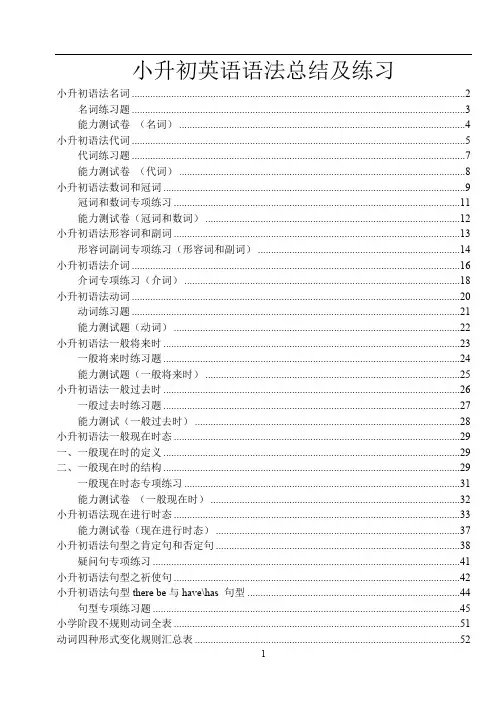
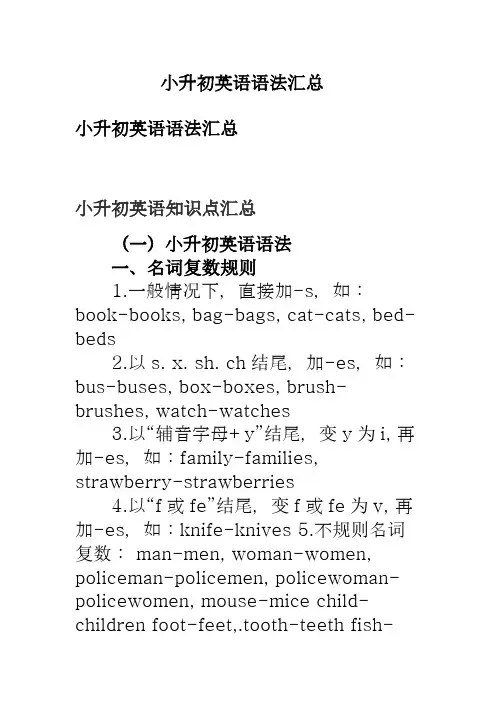
小升初英语语法汇总小升初英语语法汇总小升初英语知识点汇总(一)小升初英语语法一、名词复数规则1.一般情况下,直接加-s,如:book-books, bag-bags, cat-cats, bed-beds2.以s. x. sh. ch结尾,加-es,如:bus-buses, box-boxes, brush-brushes, watch-watches3.以“辅音字母+y”结尾,变y为i, 再加-es,如:family-families, strawberry-strawberries4.以“f或fe”结尾,变f或fe为v, 再加-es,如:knife-knives5.不规则名词复数: man-men, woman-women, policeman-policemen, policewoman-policewomen, mouse-mice child-children foot-feet,.tooth-teeth fish-fish, people-people, Chinese-Chinese, Japanese-Japanese二、一般现在时1.一般现在时表示经常或习惯性的动作,也可表示现在的状态或主语具备的性格和能力。
2.一般现在时中,没有be动词和情态动词,主语为第三人称单数的肯定句,动词要按规则加上s,主语是非第三人称单数的肯定句,动词用原形。
3.在一般现在时中,句中有be动词或情态动词时,否定句在be动词和情态动词后加not,一般疑问句将be动词或情态动词放在句首。
4.在一般现在时中,句中没有be动词或情态动词时,主语为第三人称单数的否定句在动词前加does+not (doesn’t),一般疑问句在句首加does,句子中原有动词用原形;主语为非第三人称单数,否定句用do+not (don’t),一般疑问句在句首加do,句子中动词用原形。
动词+s的变化规则1.一般情况下,直接加-s,如:cook-cooks, milk-milks2 .以s. x. sh. ch. o结尾,加-es,如:guess-guesses, wash-washes, watch-watches, go-goes3.以“辅音字母+y”结尾,变y为i, 再加-es,如:study-studies三、现在进行时1.现在进行时表示现在正在进行或发生的动作,也可表示当前一段时间内的活动或现阶段正在进行的动作。
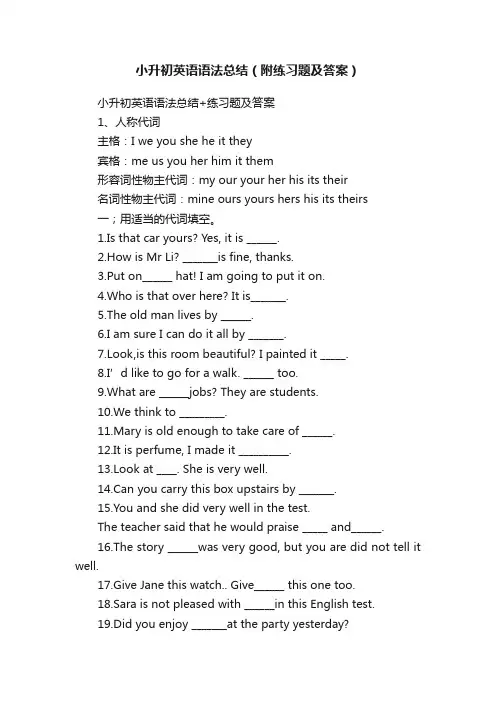
小升初英语语法总结(附练习题及答案)小升初英语语法总结+练习题及答案1、人称代词主格:I we you she he it they宾格:me us you her him it them形容词性物主代词:my our your her his its their名词性物主代词:mine ours yours hers his its theirs一;用适当的代词填空。
1.Is that car yours? Yes, it is ______.2.How is Mr Li? _______is fine, thanks.3.Put on______ hat! I am going to put it on.4.Who is that over here? It is_______.5.The old man lives by ______.6.I am sure I can do it all by _______.7.Look,is this room beautiful? I painted it _____.8.I’d like to go for a walk. ______ too.9.What are ______jobs? They are students.10.We think to _________.11.Mary is old enough to take care of ______.12.It is perfume, I made it __________.13.Look at ____. She is very well.14.Can you carry this box upstairs by _______.15.You and she did very well in the test.The teacher said that he would praise _____ and______.16.The story ______was very good, but you are did not tell it well.17.Give Jane this watch.. Give______ this one too.18.Sara is not pleased with ______in this English test.19.Did you enjoy _______at the party yesterday?20.She wants to buy a car of _____own.二:选择填空.1. Mr. More has more money than Mr. Little . But he doesn’t enjoy _______.A. heB. himC. hisD. himself2. Lily was 9 years old. _____ was old enough to go to school ________.A. She , sheB. She , herselfC. Her, herselfD. Her. she3. Jim’s watch is much newer than _________.A. hersB.sheC. herD. herself4.Would you like _____for super?A: something Chinese B:Chinese somethingC: anything Chinese D: Chinese anything5.______ piano is too old ,but she still liked playing it.A. SheB. She’sC. HersD. Her6.Who taught you English last year?Nobody taught me . I taught ______.A. meB. myselfC. mineD. I7.That bike is _________?A.he B. him C. his D. it8. We bought ______ a present, but _______ didn‖t like it.A. they, themB. them , theyC. themselves , theirD. theirs, they答案:1. mine2. he3. your4. her5. here6. myself7. myself8. me9. those10. ourselves11. herself12. myself13. her14. yourself15. you, her16. you made17. her18. her results19. yourself20. her1. D2. B3. A4. C5. D6. B7. C8. B2.形容词和副词的比较级(1) 一般在形容词或副词后+erolder taller longer stronger, etc(2) 多音节词前+moremore interesting, etc.(3) 双写最后一个字母,再+erbigger fatter, etc.(4) 把y变i,再+erheavier, earlier(5) 不规则变化:well-better, much/many-more, etc.3.可数词的复数形式一、名词复数规则1.一般情况下,直接加-s,如:book-books, bag-bags, cat-cats, bed-beds2.以s. x. sh. ch结尾,加-es,如:bus-buses, box-boxes, brush-brushes, watch-watches 3.以―辅音字母+y‖结尾,变y为i, 再加-es,如:family-families,strawberry-strawberries4.以―f或fe‖结尾,变f或fe为v, 再加-es,如:knife-knives 5.不规则名词复数:man-men, woman-women, policeman-policemen, policewoman-policewomen, mouse-micechild-childrenfoot-feet,.tooth-teethfish-fish, people-people, Chinese-Chinese, Japanese-Japanese写出下列各词的复数I _________him _________this ___________her ______watch _______child _______photo ________diary ______day________ foot________ book_______ dress ________tooth_______ sheep ______box_______ strawberry _____thief _______yo-yo ______ peach______ sandwich ______man______ woman_______ paper_______ juice___________water________ milk________ rice__________ tea__________4.不可数名词(单复数形式不变)bread, rice, water ,juice etc.5. 缩略形式I’m = I am you’re = you are she’s = she is he’s = he is it’s = it is who’s =who is can’t =can not isn’t=is not etc6 冠词冠词的定义冠词是置于名词之前,对名词起限制作用的一种虚词。
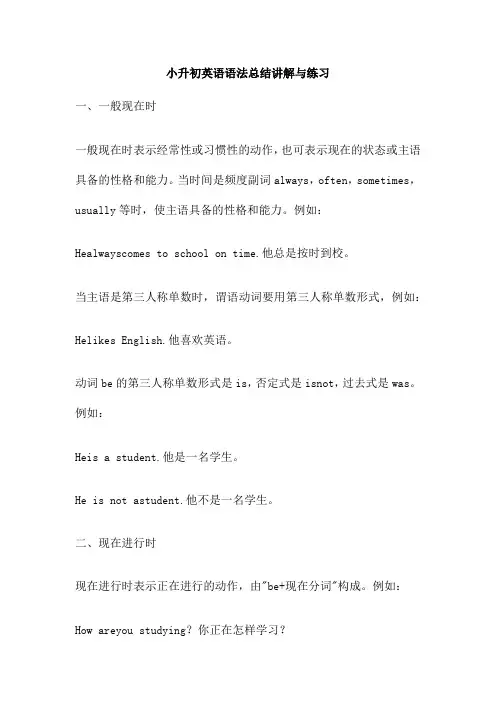
小升初英语语法总结讲解与练习一、一般现在时一般现在时表示经常性或习惯性的动作,也可表示现在的状态或主语具备的性格和能力。
当时间是频度副词always,often,sometimes,usually等时,使主语具备的性格和能力。
例如:Healwayscomes to school on time.他总是按时到校。
当主语是第三人称单数时,谓语动词要用第三人称单数形式,例如:Helikes English.他喜欢英语。
动词be的第三人称单数形式是is,否定式是isnot,过去式是was。
例如:Heis a student.他是一名学生。
He is not astudent.他不是一名学生。
二、现在进行时现在进行时表示正在进行的动作,由"be+现在分词"构成。
例如:How areyou studying?你正在怎样学习?三、现在完成时现在完成时表示动作发生在过去但与现在有,由"have+过去分词"构成。
例如:Have you finished your homework?大家的作业写完了吗?小升初英语语法总结一、动词时态一般现在时定义:表示通常性、规律性、习惯性的状态或者动作(有时间规律发生的事件)的一种时间状态。
用法:1、表示经常性或习惯性的动作或存在的状态。
2、表示主语具备的性格和能力。
3、表示不受时间限制的真理或事实。
例句:I have a pen.我有一支钢笔。
He always goes to school by bike.他总是骑自行车去学校。
They work hard all day.他们整天努力工作。
There is a book on the table.桌子上有本书。
二、现在进行时定义:表示现阶段或说话时正在进行的动作及行为。
用法:1、表示一个正在进行的动作。
这个动作发生的时间往往与说话人的说话时间基本一致。
2、表示在现阶段正在进行或发生的动作,但这个动作将延续到说话人所提及的时间为止。
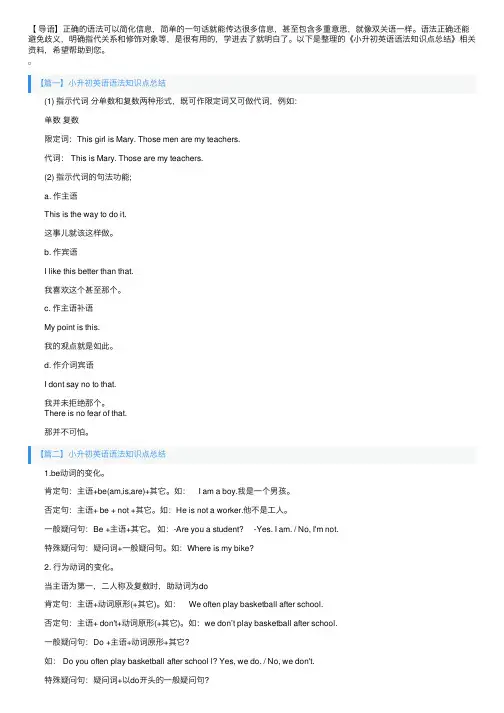
【导语】正确的语法可以简化信息,简单的⼀句话就能传达很多信息,甚⾄包含多重意思,就像双关语⼀样。
语法正确还能避免歧义,明确指代关系和修饰对象等,是很有⽤的,学进去了就明⽩了。
以下是整理的《⼩升初英语语法知识点总结》相关资料,希望帮助到您。
【篇⼀】⼩升初英语语法知识点总结 (1) 指⽰代词分单数和复数两种形式,既可作限定词⼜可做代词,例如: 单数复数 限定词:This girl is Mary. Those men are my teachers. 代词: This is Mary. Those are my teachers. (2) 指⽰代词的句法功能; a. 作主语 This is the way to do it. 这事⼉就该这样做。
b. 作宾语 I like this better than that. 我喜欢这个甚⾄那个。
c. 作主语补语 My point is this. 我的观点就是如此。
d. 作介词宾语 I dont say no to that. 我并未拒绝那个。
There is no fear of that. 那并不可怕。
【篇⼆】⼩升初英语语法知识点总结 1.be动词的变化。
肯定句:主语+be(am,is,are)+其它。
如: I am a boy.我是⼀个男孩。
否定句:主语+ be + not +其它。
如:He is not a worker.他不是⼯⼈。
⼀般疑问句:Be +主语+其它。
如:-Are you a student? -Yes. I am. / No, I'm not. 特殊疑问句:疑问词+⼀般疑问句。
如:Where is my bike? 2. ⾏为动词的变化。
当主语为第⼀,⼆⼈称及复数时,助动词为do 肯定句:主语+动词原形(+其它)。
如: We often play basketball after school. 否定句:主语+ don't+动词原形(+其它)。


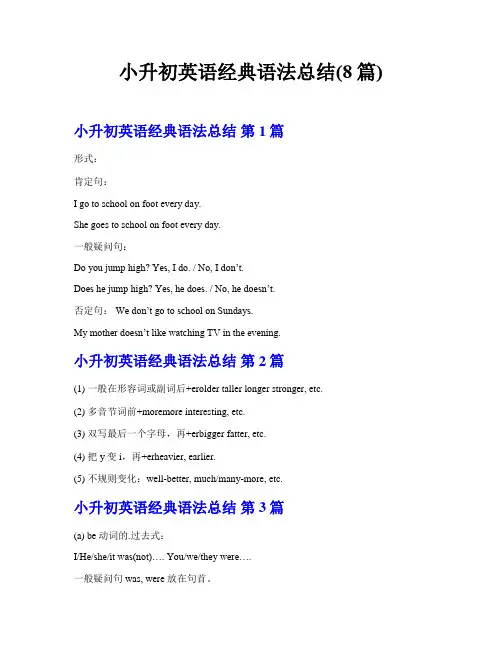
小升初英语经典语法总结(8篇)小升初英语经典语法总结第1篇形式:肯定句:I go to school on foot every day.She goes to school on foot every day.一般疑问句:Do you jump high? Yes, I do. / No, I don’t.Does he jump high? Yes, he does. / No, he doesn’t.否定句:We don’t go to school on Sundays.My mother doesn’t like watching TV in the evening.小升初英语经典语法总结第2篇(1) 一般在形容词或副词后+erolder taller longer stronger, etc.(2) 多音节词前+moremore interesting, etc.(3) 双写最后一个字母,再+erbigger fatter, etc.(4) 把y变i,再+erheavier, earlier.(5) 不规则变化:well-better, much/many-more, etc.小升初英语经典语法总结第3篇(a) be 动词的.过去式:I/He/she/it was(not)…. You/we/they were….一般疑问句was, were 放在句首。
(b) 动词过去式:肯定句: I watched cartoons.She visited the zoo.一般疑问句:Did you read book last night? Yes, I did. No, I didn’t. Did she clean the desk just now? Yes, she did. No, she didn’t.否定句:They didn’t go the the part yesterday.He didn’t make model ships last week.(3)动词过去式的变化:规则动词的变化:Most verbs +ed eg. planted,watered,climbed。
小升初英语_完整总结_六年级英语__语法附练习与答案小升初英语语法复习要点不规则动词变化表不规则动词变化表词义现在(原形)过去-ing形(动名词)是am (be) was being 是are (be) were being是be was, were being成为become became becoming开始begin began beginning弯曲bend bent bending吹blow blew blowing买buy bought buying能can could --------捕捉catch caught catching选择choose chose choosing来come came coming切cut cut cutting做do, does did doing画draw drew drawing饮drink drank drinking吃eat ate eating感觉feel felt feeling发现find found finding飞fly flew flying忘记forget forgot forgetting得到get got getting给give gave giving走go went going成长grow grew growing有have, has had having听hear heard hearing受伤hurt hurt hurting保持keep kept keeping知道know knew knowing学习learn learned, learnt learning允许,让let let letting躺lie lay lying制造make made making可以may might -----意味mean meant meaning会见meet met meeting必须must must -----放置put put putting读read read reading骑、乘ride rode riding响、鸣ring rang ringing跑run ran running说say said saying看见see saw seeing将shall should ----- 唱歌sing sang singing坐下sit sat sitting睡觉sleep slept sleeping说speak spoke speaking度过spend spent spending补充:缩略形式写出下列词的完全形式can’t_________I’d_________aren’t________they’re ____ let’s_________wasn’t_______that’s________don’t_____ when’s_______didn’t________you’re_______doesn’t ___he’s________she’s________I’m_______isn’t _________ I’ve________shouldn’t_______I’ll_________who’s ______介词基数词和序数词基数词序数词0 zero1 one first/1st 第一2 two second/2nd 第二3 three third/3rd 第三4 four fourth/4th 第四5 five fifth/5th 第五6 six sixth/6th 第六7 seven seventh/7th 第七8 eight eighth/8th 第八9 nine ninth/9th 第九10 ten tenth/10th 第十11 eleven eleventh/11th 第十一12 twelve twelfth/12th 第十二13 thirteen thirteenth/13th 第十三14 fourteen fourteenth/14th 第十四15 fifteen fifteenth/15th 第十五16 sixteen sixteenth/16th 第十六17 seventeen seventeenth/17th 第十七18 eighteen eighteenth/18th 第十八19 nineteen nineteenth/19th 第十九20 twenty twentieth/20th 第二十21 Twenty-one twenty-first/21st 第二十一22 Twenty-two twenty-second/22nd 第二十二23 Twenty-three twenty-third/23rd 第二十三30 thirty thirtieth/30th 第三十40 forty fortieth/40th 第四十50 fifty fiftieth/50th 第五十60 sixty sixtieth/60th 第六十70 seventy seventieth/70th 第七十80 eighty eightieth/80th 第八十90 ninety ninetieth/90th 第九十100 hundred hundredth/100th 第一百小升初英语语法复习要点讲解和练习代词人称代词和物主代词1、人称代词主格和宾格的区别:主格通常位于句中第一个动词之前(有时候位于than 之后),宾格一般位于动词或介词之后。
小升初英语语法总结+练习题及答案1. 人称代词主格:I we you she he it they宾格:me us you her him it them形容词性物主代词:my our your her his its their名词性物主代词:mi ne ours yours hers his its theirs一;用适当的代词填空。
I. Is that car yours? Yes, it is ______ .2. How is Mr Li? ______ is fine, tha nks.3. Put on ____ hat! I am going to put it on.4. Who is that over here? It is ______ .5. The old man lives by ____ .6.1 am sure I can do it all by _______ .7. ___________________________________ Look,is this room beautiful? I pain ted it .8.1 ' d like g o for a walk. _____ too.9. What are _____ obs? They are stude nts.10. We thi nk to _______ .II. Mary is old eno ugh to take care of_____ .12.It is perfume, I made it _________ .13. Look at __ . She is very well.14. Ca n you carry this box upstairs by______ .15. You and she did very well in the test.The teacher said that he would praise _____ a nd _____ .16. The story _____ was very good, but you are did not tell it well.17. Give Jane this watch.. Give ____ this one too.18.Sara is not pleased with ______ in this English test.19.Did you enjoy ______ at the party yesterday?20.She wants to buy a car of ____ own.二:选择填空.1. Mr. More has more money than Mr. Little . But he doesn ' t enjoy _______A. heB. himC. hisD. himself2. Lily was 9 years old. _____ was old eno ugh to go to school _______ .A. She , sheB. She , herselfC. Her, herselfD. Her. she3. Jim' s watch is much newer than ________ .A. hersB.sheC. herD. herself4. Would you like ___ for super?A: something Chinese B: Chinese somethingC: anything Chin ese D: Chin ese any thi ng5. ____ pia no is too old ,but she still liked play ing it.A. SheB. She SC. HersD. Her6. Who taught you En glish last year?Nobody taught me . I taught ______ .A. meB. myselfC. mi neD. I7. That bike is _______ ?A. heB. himC. hisD. it8. We bought ____ a present, but _______ didn ” t like it.A. they, themB. them , theyC. themselves , theirD. theirs, they答案:1. mi ne2. he3. your4. her5. here6. myself7. myself8. me9. those10. ourselves11. herself12. myself13. her14. yourself15. you, her16. you made17. her18. her results19. yourself20. her1. D2. B3. A4. C5. D6. B7. C8. B2. 形容词和副词的比较级(1) 一般在形容词或副词后+erolder taller Ion ger stron ger, etc(2) 多音节词前+moremore in teresti ng, etc.(3) 双写最后一个字母,再+erbigger fatter, etc.⑷把y变i,再+erheavier, earlier(5)不规则变化:well-better, much/ma ny-m ore, etc.3. 可数词的复数形式一、名词复数规则1. 一般情况下,直接力卩-s, 如:book-books, bag-bags, cat-cats, bed-beds2. 以s. x. sh. ch结尾,力卩-es,如:bus-buses, box-boxes, brush-brushes, watch-watches3. 以辅音字母+y”结尾,变y为i,再加-es,如:family-families, strawberry-strawberries4. 以“或fe结尾,变f或fe为v,再加-es,如:knife-knives5. 不规则名词复数:man-men, woma n-wome n, policema n-policeme n, policewoma n-policewome n, mouse-mice child-childre nfoot-feet,.tooth-teethfish-fish, people-people, Chin ese-Ch in ese, Japa nese-Japa nese写出下列各词的复数4. 不可数名词(单复数形式不变)bread, rice, water ,juice etc.5. 缩略形式I ' m = I am you ' re = you are she ' s = shesis he ' s = heit ' s = it is who ' s =who is can ' t =can not isn ' t=is not etc6冠词冠词的定义冠词是置于名词之前,对名词起限制作用的一种虚词。
小升初英语语法总结及练习小升初语法名词 (1)名词练习题 (3)能力测试卷(名词) (4)小升初语法代词 (6)代词练习题 (9)能力测试卷(代词) (10)小升初语法数词和冠词 (11)冠词和数词专项练习 (14)能力测试卷(冠词和数词) (14)小升初语法形容词和副词 (15)形容词副词专项练习(形容词和副词) (14)小升初语法介词 (16)介词专项练习(介词) (18)小升初语法动词 (20)动词练习题 (27)能力测试题(动词) (28)小升初语法一般将来时 (29)一般将来时练习题 (30)能力测试题(一般将来时) (31)小升初语法一般过去时 (32)一般过去时练习题 (33)能力测试(一般过去时) (34)小升初语法一般现在时态 (35)一、一般现在时的定义 (35)二、一般现在时的结构 (35)一般现在时态专项练习 (37)能力测试卷(一般现在时) (38)小升初语法现在进行时态 (39)能力测试卷(现在进行时态) (42)小升初语法句型之肯定句和否定句 (43)疑问句专项练习 (46)小升初语法句型之祈使句 (47)小升初语法句型there be与have\has 句型 (49)句型专项练习题 (50)小学阶段不规则动词全表 (56)动词四种形式变化规则汇总表 (58)小升初语法名词一、名词复数规则1.一般情况下,直接加-s,如:book-books, bag—bags, cat-cats, bed—beds2.以s。
x。
sh。
ch结尾,加—es,如:bus—buses, box—boxes, brush—brushes,watch—watches3.以“辅音字母+y”结尾,变y为i, 再加-es,如:family—families, strawberry-strawberries以“元音字母+y”结尾,直接加s,如:boy — boys ,day — days4。
以“f或fe”结尾,变f或fe为v,再加-es,如:knife—knives5.以o结尾的单词:a,有生命的+es b, 无生命+s如:potato—-potatoes ; hero-—heroes;mango-—mangoesphoto——photos ; radio —- radios ; video -- videos 6. 不规则名词复数:man-menwoman-women policeman—policeme nmouse—mice child—children foot-feettooth-teethfish—fishpeople—peopleChinese—Chinese Japanese—Japanesedeer - deersheep—sheeppolicewoman-policewomen二、名词所有格的构成法1. 主要是在词尾加’ s 构成。
小升初英语语法复习重点1.形容词和副词的比较级(than)(1) 一般在词尾加er :older taller longer stronger等(2) 以e结尾的直接加er (3) 重读闭音节(辅+元+辅)结尾,双写最后一个字母,再加er :bigger,fatter,thinner,hotter(4) 辅音+y结尾的,把y变i,再+er :heavier, earlier, funnier(5) 不规则变化:Good/well-better-best, much/many-more-most, bad-morse-worst, little-less-lesst注:as+原级+as;动词+副词; be+形容词;看到than用比较级-er2.可数名词的复数形式1)一般情况下 + s : book –books2)以s, sh, ch,x结尾的单词 + es :glass—glasses watch-watches3)以辅音字母+y结尾,变y为 i,再加es : story—stories4)以辅音+o结尾的+es : mango—mangoes 例外a piano—pianos,photo-photos5)以f或fe 结尾的把f或fe变为v,再加es : knife –knives shelf-shelves注:●不规则的●不可数名词(单复数形式不变)例如:breadrice,water ,juice...)(3)名词所有格1、一般末尾加“'s”构成。
如:Mike's bike2、以s结尾的复数名词的所有格,只在其末尾加“’”如:my parents' car3、表示几个人共有的东西时,只在最后一个名字上加所有格。
如:Jenny and Joan's bedroom 但如果是各自拥有的东西就要在每个名字上加所有格.如:Tim's and Jack's cars4、没有生命的东西的所有格,我们通常用“of+名词”的方式来表示。
小升初英语语法重点总结与练习英语是小学生必修的学科之一,掌握好英语语法对于小升初考试至关重要。
下面将对小升初英语语法的重点进行总结,并提供一些练习来帮助学生巩固所学内容。
一、名词名词是指人、事物、地方、动物等各种事物的名称。
在句子中可用作主语、宾语、表语等成分。
名词的复数形式可以通过加-s或-es来表示,也有一些名词的复数形式需要单独记忆。
练习题:1. My sister has two ________ (cat).2. They are playing with ___________ (knife).二、代词代词可用来代替名词,在句子中充当名词的作用。
常见的代词包括人称代词、物主代词、指示代词和不定代词等。
练习题:1. Tom wants to show _______ (he) new bike to ______ (I).2. _______ (These) apples are delicious!三、动词动词是句子的核心成分,表示动作或状态。
根据谓语动词的不同形式,动词可以分为不规则动词和规则动词。
要注意动词的时态和语态的变化。
练习题:1. He ______ (go) to school every day.2. The book _______ (lose) by me yesterday.四、形容词和副词形容词用来描述名词的特征或属性,副词用来表示动作的方式、程度或频率。
形容词通常位于名词前面,副词可放在动词、形容词或其他副词前面。
练习题:1. The dog is ________ (big) than the cat.2. They speak English __________ (good).五、介词介词用来连接词语,表示它们之间的关系。
常见的介词有in、on、at、under等,要注意介词与其他词语的搭配。
练习题:1. The book is ________ the table.2. My birthday is _________ May 10th.六、连词连词用来连接词语、短语或句子,使句子结构紧凑。